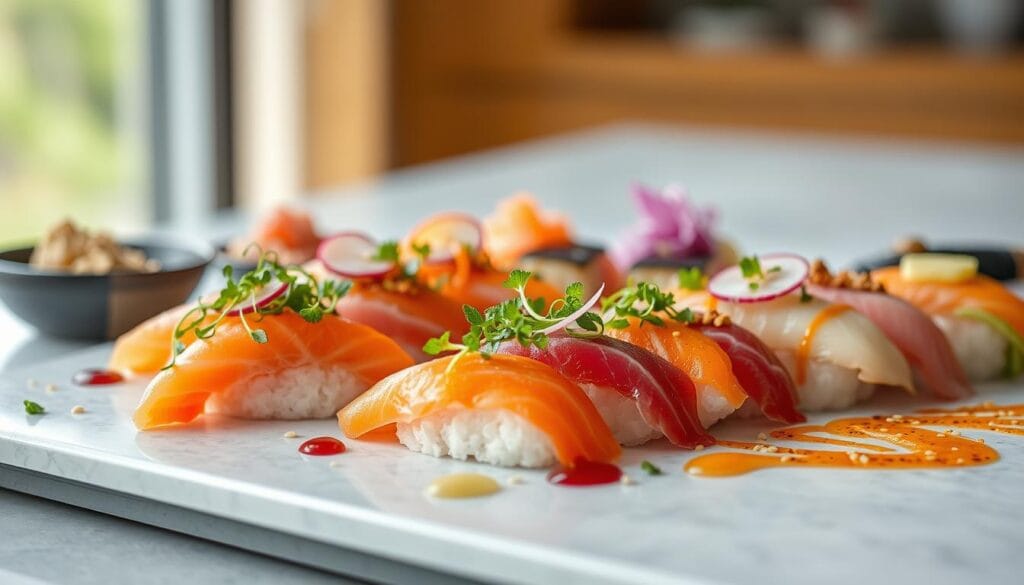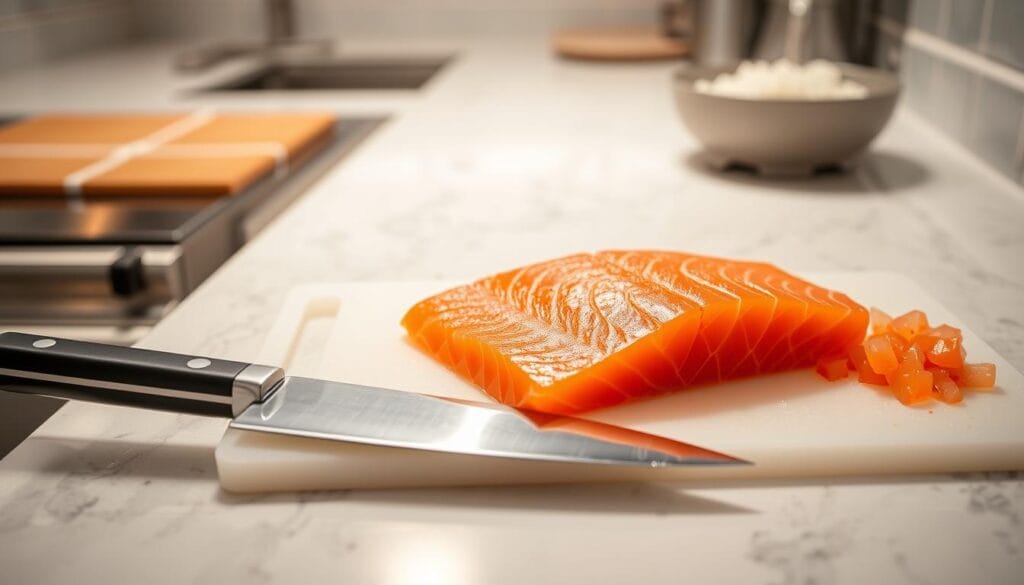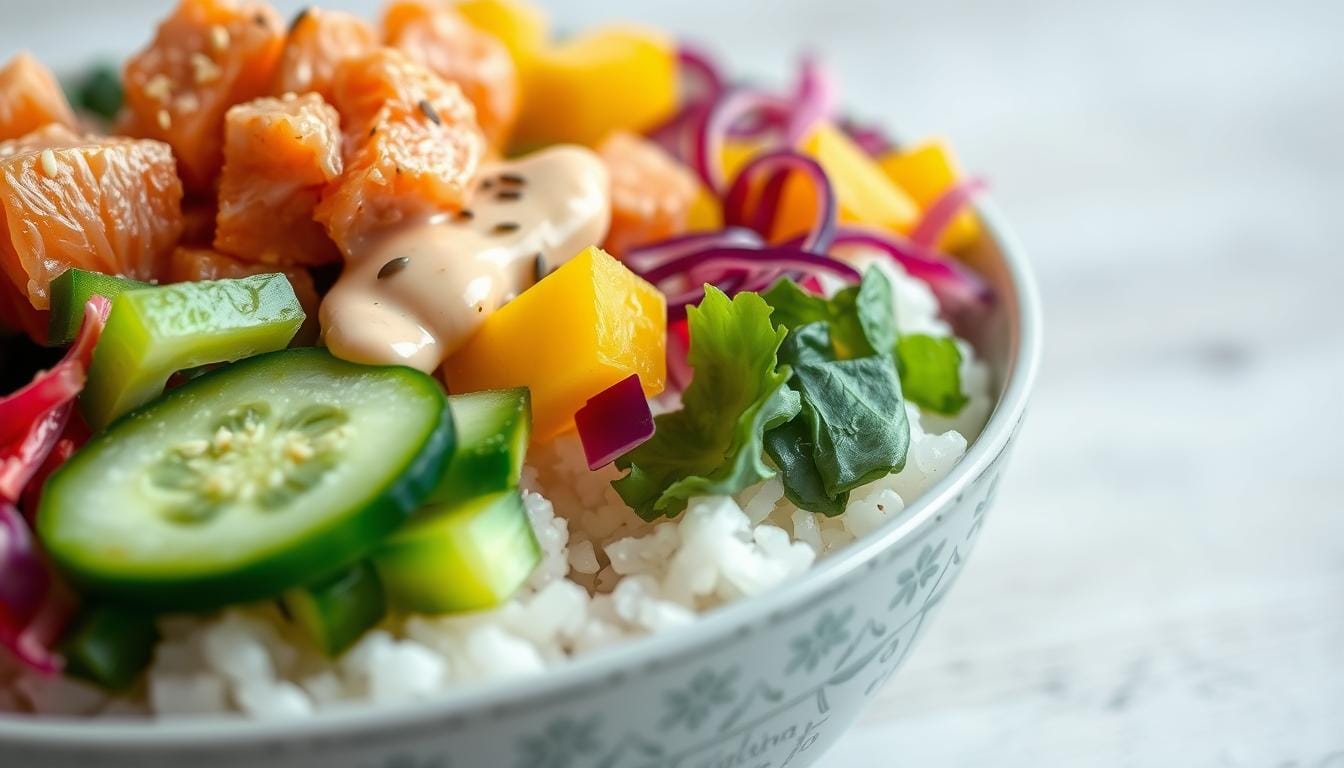Delicious Salmon Poke Recipe – Easy to Make at Home!
Have you ever craved a fresh, gourmet meal but felt it was too complicated to make at home? Think again! With just a few simple ingredients and a little preparation, you can create a restaurant-quality dish in under 10 minutes. This guide will show you how to make a flavorful and healthy meal that’s perfect for busy weeknights or casual gatherings.
The key to success lies in using sushi-grade fish, which ensures both safety and exceptional taste. Proper handling and marination techniques will elevate your dish, giving it that authentic touch. Whether you’re new to raw fish or a seasoned pro, this recipe is designed to be approachable and rewarding.
By the end of this article, you’ll have all the tips and tricks to prepare a stunning salmon poke bowl that’s as beautiful as it is delicious. Let’s dive in and discover how easy it is to bring this Hawaiian-inspired favorite to your kitchen!
Key Takeaways
- This dish is quick to prepare, taking less than 10 minutes.
- Using sushi-grade fish ensures safety and quality.
- Simple ingredients make it easy to assemble at home.
- Perfect for a healthy and flavorful meal.
- Follow proper handling techniques for the best results.
Introduction to Salmon Poke Bowls
Ever wondered how a simple dish can carry centuries of tradition? The poke bowl is more than just a meal—it’s a cultural experience rooted in Hawaiian history. Originally, poke (pronounced poh-kay) was a way for Hawaiians to enjoy fresh, raw fish seasoned with sea salt and seaweed. Over time, it evolved into the vibrant, customizable dish we know today.
History and Cultural Influence
The origins of poke trace back to ancient Hawaii, where fishermen would season their catch with what was readily available. With the arrival of Japanese immigrants, soy sauce and sesame seeds were introduced, creating a fusion of flavors. This blend of Hawaiian and Japanese techniques is what makes modern poke bowls so unique and flavorful.
Today, poke has become a global phenomenon, celebrated for its versatility and fresh ingredients. From the traditional ahi tuna to modern variations, the dish continues to evolve while staying true to its roots. Ingredients like sesame seeds, fresh vegetables, and tangy sauces add layers of texture and taste, making every bite a delight.
Why You’ll Love This Dish
What makes a bowl of poke so appealing? It’s the perfect balance of flavors and textures. The tender fish, crunchy vegetables, and nutty sesame seeds create a harmony that’s both satisfying and refreshing. Plus, it’s incredibly versatile—you can customize it to suit your taste or dietary preferences.
Whether you’re a fan of raw fish or just looking for a healthy, flavorful meal, poke offers something for everyone. Its vibrant colors and fresh ingredients make it as visually appealing as it is delicious. Dive into this Hawaiian classic and discover why it’s become a favorite around the world.
Understanding the Salmon Poke Recipe
What makes a dish stand out in a world of endless culinary options? It’s the perfect blend of quality ingredients, balanced flavors, and thoughtful preparation. This dish is no exception. Let’s explore what sets it apart and how each component plays a crucial role in creating a memorable meal.
What Makes This Dish Special?
This dish is unique because of its simplicity and depth of flavor. The star ingredient, sushi-grade fish, ensures both safety and a rich, buttery texture. Freshness is key—wild-caught varieties like sockeye or king salmon are preferred for their superior taste.
The marinade is another standout feature. A mix of soy sauce, sesame oil, and other seasonings creates a harmonious blend of umami and nutty notes. This balance elevates the dish, making it both refreshing and satisfying.
Essential Ingredients and Their Roles
Every ingredient in this dish has a purpose. Rice provides a soft, chewy base that complements the tender fish. It also absorbs the marinade, adding an extra layer of flavor.
Soy sauce brings a savory depth, while sesame oil adds a nutty finish. Together, they create a marinade that enhances the natural taste of the fish without overpowering it.
Fresh vegetables and toppings add crunch and brightness, making each bite a delightful mix of textures. From creamy avocado to crisp cucumber, every element is chosen to enhance the overall experience.
By focusing on quality and balance, this dish becomes more than just a meal—it’s a celebration of flavor and tradition.
Preparing and Handling Sushi-Grade Fish
Handling raw fish might seem intimidating, but with the right techniques, it’s simple and safe. Proper preparation ensures both the quality of your dish and your health. Let’s dive into the essential steps to handle sushi-grade fish like a pro.
Proper Thawing Techniques
If you’re using frozen fish, thawing it correctly is crucial. Always place it in the refrigerator overnight. This slow process keeps the fish at a safe temperature, preventing bacterial growth.
Never thaw fish at room temperature or in warm water. These methods can compromise its texture and safety. Patience is key to maintaining the fish’s quality.
Maintaining Food Safety and Hygiene
Sanitizing your workspace is non-negotiable. Clean cutting boards and utensils with hot, soapy water before use. This step minimizes the risk of cross-contamination.
After preparing the fish, consume it immediately or store it in the fridge. Raw fish should not sit at room temperature for more than two hours. This ensures freshness and safety.
Here’s a quick guide to handling sushi-grade fish:
- Thaw frozen fish in the refrigerator overnight.
- Sanitize all surfaces and tools before use.
- Remove the skin carefully using a sharp knife.
- Cut the fish into even cubes for consistent texture.
- Consume or refrigerate immediately after preparation.
“Proper handling and hygiene are the foundation of any great dish. Take your time, and you’ll be rewarded with exceptional results.”
By following these steps, you’ll ensure your dish is not only delicious but also safe to enjoy. Remember, quality starts with how you handle your ingredients.
Creating the Perfect Marinade
Crafting the ideal marinade is the secret to unlocking bold, layered flavors in your dish. It’s where savory, nutty, and spicy elements come together to elevate your meal. Let’s explore how to mix these ingredients for a balanced and unforgettable taste.
Balancing Soy Sauce, Sesame Oil, and Sriracha
Each ingredient in the marinade plays a vital role. Soy sauce adds a salty, umami depth, while sesame oil brings a rich, nutty aroma. A touch of sriracha introduces a subtle heat that ties everything together.
To achieve the perfect balance, start with a base of soy sauce. Add sesame oil for richness and sriracha for a hint of spice. Mix thoroughly to ensure every bite is infused with flavor.
Creative Variations for Extra Zest
Want to take your marinade to the next level? Try adding a dollop of mayo for creaminess or finely chopped green onion for a fresh, zesty kick. These additions can enhance the texture and complexity of your dish.
Here’s a quick guide to customizing your marinade:
- Use soy sauce as the base for saltiness.
- Add sesame oil for a nutty finish.
- Incorporate sriracha for a spicy touch.
- Experiment with mayo or green onion for extra flavor.
Tips for Consistency and Customization
Accurate measurements are key to maintaining consistent flavor. Use a 3:1 ratio of soy sauce to sesame oil, and adjust sriracha to your preferred heat level. Taste as you go and tweak the ingredients to suit your palate.
| Ingredient | Role | Recommended Amount |
|---|---|---|
| Soy Sauce | Salty, umami base | 3 tablespoons |
| Sesame Oil | Nutty aroma | 1 tablespoon |
| Sriracha | Spicy kick | 1 teaspoon |
By mastering the art of marinade-making, you can create a dish that’s bursting with flavor and tailored to your taste. Whether you stick to the basics or experiment with creative twists, the perfect marinade is within your reach.
Crafting a Delicious Salmon Poke Bowl
The foundation of a great dish often lies in its base, and choosing the right rice can make all the difference. The rice you select not only complements the flavors but also enhances the overall texture of your meal. Whether you prefer traditional sushi rice or a healthier alternative, the choice is yours.
Choosing the Ideal Rice Base for Your Bowl
Sushi rice is the classic choice, known for its sticky texture and ability to absorb flavors. It pairs perfectly with the marinade, creating a harmonious bite every time. For a lighter option, brown rice offers a nutty flavor and added fiber.
If you’re looking for something aromatic, jasmine rice is a great alternative. Its floral scent and soft texture make it a popular choice in many Asian cuisines. No matter which type you choose, ensure it’s cooked to the right consistency—soft but not mushy.
“The right rice can elevate your dish from good to extraordinary. It’s all about balance and texture.”
Here’s a quick guide to the best rice options for your bowl:
| Rice Type | Texture | Flavor Profile |
|---|---|---|
| Sushi Rice | Sticky | Mild, slightly sweet |
| Brown Rice | Chewy | Nutty, earthy |
| Jasmine Rice | Soft | Aromatic, floral |
When serving, ensure the rice is warm but not hot. This way, it blends seamlessly with the other ingredients without overpowering them. For those who prefer variety, tuna can be a great alternative to the main ingredient, offering a different yet equally delicious experience.
Using sushi-grade ingredients ensures both safety and flavor. Always store your rice properly and consume it within a day for the best results. With the right base, your dish will be a flavorful and satisfying meal every time.
Innovative Toppings and Enhancements
Transform your dish with creative toppings that add both flavor and texture. Whether you’re a fan of fresh vegetables or crave a spicy kick, the right enhancements can take your meal to the next level. Let’s explore how to elevate your dish with innovative ingredients.

Fresh Vegetables and Pickled Elements
Fresh vegetables like cucumber, avocado, and radish add a crisp, refreshing crunch to your dish. They balance the richness of sushi sushi-grade fish, creating a harmonious bite. For a tangy twist, try pickled cucumbers or carrots. These elements introduce a zesty contrast that enhances the overall flavor profile.
Using raw fish as the base ensures a light and healthy meal. Pair it with microgreens or shiso leaves for an extra burst of freshness. These toppings not only add visual appeal but also pack a nutritional punch.
Adding a Spicy Kick with Sriracha Mayo
For those who love heat, sriracha mayo is a game-changer. This creamy, spicy sauce complements the buttery texture of spicy salmon perfectly. It’s easy to make—just mix sriracha with mayo for a quick, flavorful drizzle.
If you’re using other sushi sushi-grade fish, like tuna or yellowtail, sriracha mayo works equally well. It adds depth and complexity, making every bite unforgettable. Adjust the spice level to suit your taste, and enjoy the bold flavors it brings to your dish.
Here are some topping ideas to inspire your next creation:
- Pickled ginger for a tangy, aromatic touch.
- Thinly sliced scallions for a mild, oniony flavor.
- Crunchy tempura flakes for added texture.
- Edamame beans for a protein boost.
By experimenting with these toppings, you can create a dish that’s uniquely yours. Whether you stick to traditional ingredients or try something new, the possibilities are endless. Enjoy the process of crafting a meal that’s as vibrant and flavorful as it is satisfying.
Step-by-Step Assembly Instructions
Assembling a flavorful dish at home is easier than you think with these step-by-step instructions. Follow this guide to create a meal that’s both visually appealing and delicious.
Start by preparing your base. Layer a generous portion of cooked rice at the bottom of your bowl. This provides a soft, chewy foundation that complements the other ingredients. For added flavor, consider seasoning the rice with a splash of vinegar.
Next, add your marinated sushi-grade salmon. Cut the fish into even cubes for consistent texture and arrange them neatly over the rice. The marinade will infuse the dish with rich, savory notes.
Now, it’s time to incorporate fresh vegetables. Thinly slice a cucumber for a crisp, refreshing crunch. For a tangy twist, quick-pickle the cucumber by soaking it in a mixture of vinegar, sugar, and salt for 10 minutes. This adds a zesty contrast to the dish.
Enhance the creaminess of your bowl by adding sliced avocado. Its buttery texture pairs perfectly with the tender fish and crunchy vegetables. Arrange the avocado slices evenly for a balanced bite.
Here’s a quick checklist for assembling your dish:
- Layer cooked rice as the base.
- Add marinated sushi-grade salmon cubes.
- Include fresh or pickled cucumber for crunch.
- Top with sliced avocado for creaminess.
“Proper layering ensures every bite is a harmonious blend of flavors and textures. Take your time to arrange each ingredient thoughtfully.”
Finish with a sprinkle of sesame seeds or a drizzle of soy sauce for extra flavor. Serve immediately to enjoy the freshness of your creation. With these steps, you’ll have a dish that’s as beautiful as it is delicious.
Culinary Techniques for Raw Fish Preparation
Mastering the art of raw fish preparation starts with precision and the right tools. Whether you’re a beginner or an experienced cook, proper techniques ensure your dish is both safe and delicious. Let’s dive into the essentials of handling and preparing sushi-grade fish at home.
Knife Skills and Optimal Chopping Methods
Using a sharp knife is crucial for clean, even cuts. A dull blade can tear the fish, affecting its texture and presentation. For best results, invest in a high-quality chef’s knife or sashimi knife. These tools are designed to slice through raw fish smoothly.
When chopping, aim for uniform pieces—about ½-inch cubes. This size ensures each bite is balanced and easy to eat. Start by removing the skin, then slice the fish into even strips before cutting into cubes. Precision in cutting not only enhances texture but also improves the dish’s overall presentation.

Handling sushi-grade fish at home requires attention to detail. Always work on a clean, sanitized surface to prevent contamination. After cutting, store the fish in the refrigerator if not using immediately. This preserves its freshness and quality.
Practical Tips for Safe and Efficient Preparation
Here are some key steps to ensure your preparation process is smooth and safe:
- Use a sharp knife for clean, precise cuts.
- Cut the fish into uniform ½-inch cubes for consistency.
- Sanitize your workspace and tools before and after use.
- Store the fish in the refrigerator if not consuming right away.
Cleaning your knives and surfaces after handling raw fish is equally important. Wash them with hot, soapy water to eliminate any bacteria. This step ensures your kitchen remains safe and hygienic.
| Tool | Purpose | Care Tips |
|---|---|---|
| Chef’s Knife | Slicing and chopping | Sharpen regularly, hand wash |
| Cutting Board | Prepping surface | Sanitize after each use |
| Fish Tweezers | Removing bones | Clean with soap and water |
By following these techniques, you’ll handle sushi-grade fish like a pro. Whether you’re preparing a simple dish or experimenting with new flavors, precision and care make all the difference. Enjoy the process and savor the results of your hard work!
Adapting the Recipe to Your Lifestyle
Customizing your meal to fit dietary needs doesn’t have to be complicated. With a few simple swaps, you can enjoy this dish while staying true to your lifestyle. Whether you’re gluten-free, allergy-conscious, or just looking for healthier options, these modifications make it easy to adapt.
Gluten-Free and Allergy-Friendly Modifications
For those with gluten sensitivity, swap traditional soy sauce with coconut aminos. This alternative offers a similar savory flavor without the gluten. It’s a simple change that keeps the dish safe and delicious.
If you’re avoiding allergens, consider using tamari instead of soy sauce. Tamari is naturally gluten-free and works well in the marinade. Always check labels to ensure it meets your dietary requirements.
Alternative Toppings for Dietary Preferences
Toppings can make or break your dish. For a healthier twist, try adding quinoa instead of rice. It’s gluten-free and packed with protein. If you’re watching carbs, cauliflower rice or lettuce wraps are excellent options.
For extra crunch, include edamame or cucumber boats. These add texture and nutrients without compromising flavor. If you’re vegan, swap the fish for marinated tofu or tempeh.
Measuring Ingredients for Consistent Flavor
When substituting ingredients, accurate measurements are key. Use a cup or tablespoon to ensure the right balance of flavors. For example, if using coconut aminos, stick to the same amount as soy sauce to maintain the dish’s savory profile.
Sourcing High-Grade Ingredients
Quality matters, especially when adapting recipes. Look for sushi-grade fish or alternatives like canned tuna for convenience. For gluten-free options, choose certified products to avoid cross-contamination.
| Ingredient | Substitution | Purpose |
|---|---|---|
| Soy Sauce | Coconut Aminos | Gluten-Free Alternative |
| Rice | Quinoa | Higher Protein Option |
| Fish | Tofu | Vegan Alternative |
| Tempura Flakes | Edamame | Allergy-Friendly Topping |
By making these adjustments, you can enjoy a dish that fits your dietary needs without sacrificing flavor. Whether you’re gluten-free, vegan, or just exploring healthier options, these tips ensure a satisfying meal every time.
Conclusion
Creating a flavorful and balanced meal at home is simpler than you might think. By following clear instructions, you can achieve a dish that combines the perfect texture and taste. Each piece of fish, marinated with just a tablespoon of seasoning, contributes to a harmonious blend of flavors.
Using high-quality ingredients ensures both safety and exceptional results. The right techniques, from precise cutting to proper marination, make all the difference. This dish is not only delicious but also highly customizable. Experiment with toppings and modifications to create your perfect bowl.
We encourage you to try this at home and share your results. Have questions or need tips? Feel free to reach out. Your culinary journey starts here!
FAQ
What is sushi-grade fish, and why is it important?
Can I use regular soy sauce for the marinade?
How do I properly thaw sushi-grade fish?
What’s the best rice to use for a poke bowl?
Can I make this dish ahead of time?
What are some creative toppings I can add?
Is this recipe suitable for gluten-free diets?
How can I make the marinade less spicy?
Can I substitute tuna for salmon in this recipe?
What’s the best way to chop the fish for a poke bowl?
There are no reviews yet. Be the first one to write one.

